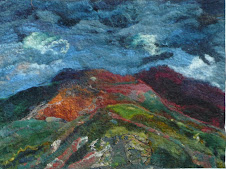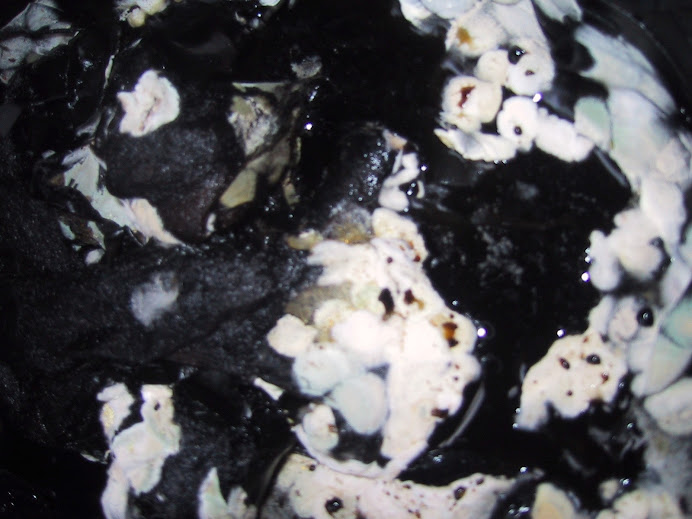
The colours are a little more muted than before and I think slightly dulled which is what Michelle Wipplinger in her booklet on dyeing with the extract dyes says happens with gum arabic but the consistency is different from dyes thickened with gum tragacanth which is what I use for printing and stencilling. I had a friend with me and we spent the afternoon playing with the inks and she found it disppointing that the inks did not move and blend in in the same way as unthickened ones. I quite like the fact the dyes stayed more where they were put instead of flowing into one another! Here is my study of a decaying leaf-part of a series for a wallhanging in gossamer felt of floating leaves. The quite bright orange was a cheat! I made it up by dissolving 1/4tsp of annatto extract in 50ml of hot water.
So first of all I need to make up the gum arabic properly - jsut dissolving it in hot water not heating it. Then I think I need to make more intense colours both the saffron,and the logwood were disappointing and I think Imight have a bash at making a red as the cochineal and tin still went more to the pink so mixing cochineal and madder possibly. Although on it's own madder makes a disppointing paint givng a dull pink
I have now got one of the books recomnended by Dorothy- The Artist's Handbook of Materials and Techniques by Ralph Mayer. This book came very quickly via Abe books the other one on medieval inks has not yet even been acknowedged by the seller which is rather annoying. So I am busy reading and making notes. Sometimes I wonder whether I have bitten off more than I can chew but this is probably becuase I am suffering my third illness in two weeks - this time a nasty cold.
Dragon's Blood.
This one really intrigued me. I was reading up on Mediera as DH and I are going there for a holiday shortly, and it was mentioned that before Mediera was settled by the Portuguese, sailors used to visit the Island for a dye known as a dragon's blood which was a tree resin. I turned to Cardon, the only mention of it here was in passing as part of an old recipe for pink and she called it dracaena cinnabari (balf) but John and Margaret Cannon in Dye Plants and Dyeing said that dragons blood was the resin from sanderswood. It might be nice to know more but I am not sure where else to look. It would be fun to get some dye when I am on holiday, but it is unlikely I thinks as apparently the land was extensively cleared.




























Hi Helen,
ReplyDeleteSorry to be slow with info for you, I haven't found my inks recipes yet but I can tell you that there's quite a lot about dragon's blood in Victoria Finlays book - if you haven't a copy (but I think you have) mine's here!I also have Cennini if you want the references!My original recipe for ink is as follows - 1lb galls, 1/2lb copperas (iron), 1/4lb gum arabic, 1/4lb white sugar candy. Bruise the galls and beat other ingredients up fine. Infuse them all ij 3 quarts of white wine or rainwater & let them stand hot by the fire 3 - 4 days. Then put all in a new pipkin, set it on a slow fire so as not to boil. Keep it frequently stirring and let it stand 5 or 6 hours til one quarter is consumed. When cold strain it through a clean piece of linen. Bottle and keep for use. (a pipkin is an unglazed pot cooking vessel with its own feet)There's also a lovely recipe in Theophilus which tells you to cut some pieces of hawthorn wood in april or may before they grow blossom or leaves.....etc - I'll photocopy it for you!!!!
Enjoy!
Deb
I read somewhere that one way of thickening inks is with egg yolk as for egg tempera, this of could wouldonly be useable on non wash items. Have you tried mixing the inks up with skim milk powder which gives a basic type of casien paint, it may be worth experimenting with and for a thicker paint low/no fat yoghurt works well.
ReplyDeleteHello,
ReplyDeleteif you are researching "Sang Dragon", there is a short but interesting article about the tree it comes from in this month's "Garance Voyageuse". It is in French unfortunately, but as soon as I have time to scan it and publish it on by blog, I will be happy to help you with a translation.
Thank you for your blog which I find very inspiring.
Victoria
Hi Victoria I would be very interested in the article. And thank you too for the comment about the blog. It is so good to know others find it interesting and I am not being a mad dyer after all! Thanks
ReplyDeleteHello,
ReplyDeletethe article is now available at this adress:
http://plantes-couleurs.over-blog.net/article-15508806.html
Victoria